Related Research Articles

Gorillas are herbivorous, predominantly ground-dwelling great apes that inhabit the tropical forests of equatorial Africa. The genus Gorilla is divided into two species: the eastern gorilla and the western gorilla, and either four or five subspecies. The DNA of gorillas is highly similar to that of humans, from 95 to 99% depending on what is included, and they are the next closest living relatives to humans after chimpanzees and bonobos.
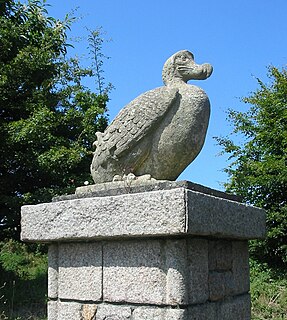
Jersey Zoo is a zoological park established in 1959 on the island of Jersey in the English Channel by naturalist and writer Gerald Durrell (1925–1995). It is operated by the Durrell Wildlife Conservation Trust. It has approximately 169,000 visitors per year; visitor numbers tend to vary with the tourist trade to Jersey.
Binti Jua is a female western lowland gorilla in the Brookfield Zoo, in Brookfield, Illinois, outside of Chicago, US. She received media attention after a situation in 1996 in which she tended to a three-year-old boy who had been injured by falling into her enclosure.

Snowflake was the world's only known albino gorilla to date. He was a western lowland gorilla. He was kept at Barcelona Zoo in Barcelona, Catalonia, Spain, from 1966 until his death.
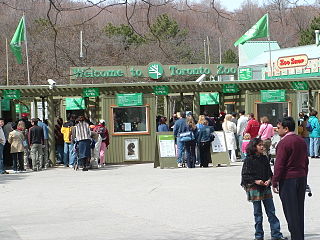
The Toronto Zoo is a zoo located in Toronto, Ontario, Canada. Encompassing 287 hectares, the Toronto Zoo is the largest zoo in Canada. It is divided into seven zoogeographic regions: Indo-Malaya, Africa, Americas, Tundra Trek, Australasia, Eurasia, and the Canadian Domain. Some animals are displayed indoors in pavilions and outdoors in what would be their naturalistic environments, with viewing at many levels. It also has areas such as the Kids Zoo, Waterside Theatre, and Splash Island. It has one of the most taxonomically diverse collection of animals on display of any zoo worldwide; it is currently home to over 5,000 animals representing over 500 species. The zoo is open to the public every day of the year except December 25.

Taronga Zoo is a zoo located in Sydney, New South Wales, Australia, in the suburb of Mosman, on the shores of Sydney Harbour. The opening hours are between 9:30 a.m. to 5 p.m.

Zoo Atlanta is an Association of Zoos and Aquariums (AZA) accredited zoological park in Atlanta, Georgia. The current president and CEO of Zoo Atlanta is Raymond B. King.

The western lowland gorilla is one of two Critically Endangered subspecies of the western gorilla that lives in montane, primary and secondary forest and lowland swampland in central Africa in Angola, Cameroon, Central African Republic, Republic of the Congo, Democratic Republic of the Congo, Equatorial Guinea and Gabon. It is the nominate subspecies of the western gorilla, and the smallest of the four gorilla subspecies.
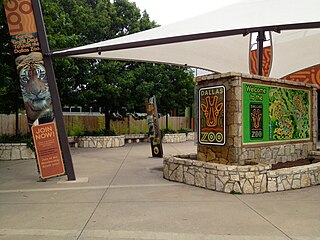
Dallas Zoo aka Dallas Zoological Park is a 106-acre (43 ha) zoo located 3 miles (5 km) south of downtown Dallas, Texas, in Marsalis Park. Established in 1888, it is the oldest and largest zoological park in Texas and is managed by the non-profit Dallas Zoological Society. It is home to over 2,000 animals representing 406 species. It is an accredited member of the Association of Zoos and Aquariums (AZA), and is a member of the World Association of Zoos and Aquariums (WAZA).

Willie B. was a western lowland gorilla who lived at the Zoo of Atlanta for 39 years, from 1961 until his death on February 2, 2000. He was named after the former mayor of Atlanta, William Berry Hartsfield. Willie B. was kept in isolation for 27 years with only a television and a tire swing to keep him company. In 1988, he was moved to an outside exhibit and allowed to socialize and raise a family. He then embraced his role as silverback and leader of a troop.
Pogo was a female western lowland gorilla who was a feature of the Gorilla World exhibit at the San Francisco Zoo. Pogo was a childless but motherly matriarch, loved by generations of San Franciscans. When she died at the age of 48, she was believed to have been one of the oldest living gorillas in captivity.
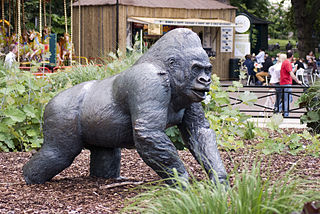
Guy the Gorilla (1946–1978) was a western lowland gorilla who was London Zoo's most famous resident and often profiled on children's TV shows and natural history productions. The exact day of Guy's birth was unknown, but the official birthday was set by the Zoo as May 30, and he received large numbers of cards each year.
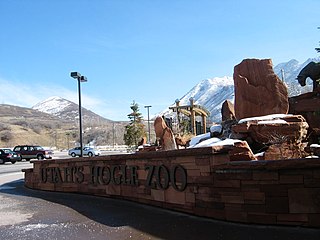
Utah's Hogle Zoo is a 42-acre (17 ha) zoo located in Salt Lake City, Utah. It houses animals from diverse ecosystems. It is located at the mouth of Emigration Canyon. Hogle is an accredited member of the Association of Zoos and Aquariums (AZA) and the World Association of Zoos and Aquariums (WAZA).
Babec was a male silverback western lowland gorilla, the youngest of three sons born to Otto and Benga at Chicago's Lincoln Park Zoo. Between 1988 and 1992 he sired 8 offspring, 5 of them with Madge of the Cincinnati Zoo. Six of his offspring survived into maturity, and he has one grandchild, Kiazi Kitamu at the Pittsburgh Zoo. Babec was exhibited at the Birmingham Zoo in Birmingham, Alabama, from 1993 until his death in 2008. He was the only gorilla to have been successfully fitted with a pacemaker, which he wore for four years.

Shabani is a male western lowland gorilla, born at the Apenheul Primate Park in the Netherlands, raised in Australia and currently residing at the Higashiyama Zoo in Nagoya, Japan. He gained publicity in 2007 at Higashiyama Zoo when he was 10 years old by tightrope walking.
Timmy was a western lowland gorilla and a 25-year-long resident of the Cleveland Metroparks Zoo. He was primarily housed indoors at the Zoo's Primate, Cat & Aquatics building. The even-tempered silverback gorilla was euthanized at the Louisville Zoo after suffering from chronic cardiovascular disease and osteoarthritis in 2011.

Louis the Gorilla is a western lowland gorilla who is known for walking upright in order to avoid muddying his hands. A clip of Louis that was posted to the Philadelphia Zoo's Facebook page became popular and he gained international fame.
Ndume is a male western lowland gorilla known for having learned a limited amount of a modified version of American Sign Language (ASL) and for being at the center of lawsuit over his custody between the Cincinnati Zoo and the Gorilla Foundation. Ndume has lived most of his life at the Gorilla Foundation's sanctuary at Woodside, California, but has also lived at the Cincinnati Zoo and the Brookfield Zoo. Following a lawsuit, which raged on for months, Ndume was transferred back to the Cincinnati Zoo from the Gorilla Foundation on June 14, 2019.
Ozoum, commonly referred to as Ozzie, was an African-born western lowland gorilla who was a subject of research at the Yerkes National Primate Research Center in the U.S. state of Georgia from 1964 until 1988, when he was transferred to Zoo Atlanta. In 2009, he was the first gorilla to "volunteer" for a blood pressure test. Before his death at age 60, he was the oldest recorded male gorilla in captivity.
References
- ↑ "More from Charles's big celebration today". Facebook . Retrieved 2022-01-19.
- ↑ "Getting to know our troop" . Retrieved 2016-03-09.
- ↑ Toronto Zoo history page on Toronto Zoo website Archived 2007-02-20 at the Wayback Machine
- ↑ "Toronto Zoo's Gorillas to Welcome New Member". Archived from the original on 2010-01-02.
- ↑ "Meet our Baby Lowland Western Gorilla, Nneka!" . Retrieved 2015-03-25.